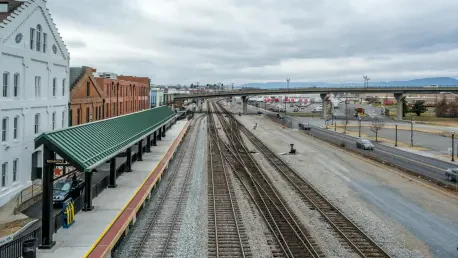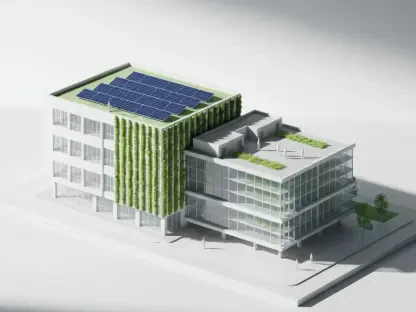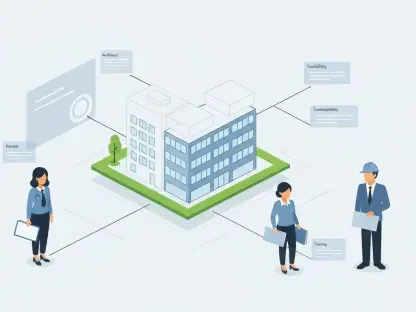The Franconia-Springfield Bypass project is poised to transform rail transit in Virginia, targeting one of the most congested rail corridors between Fredericksburg and Washington, D.C. This significant venture, steered by a joint operation of Flatiron, Dragados, and Herzog, aims to mitigate traffic congestion and boost both passenger and freight train efficiency. Overseen by the Virginia Passenger Rail Authority (VPRA), the project underscores the state’s commitment to modernizing infrastructure to meet current transportation demands. By addressing critical bottlenecks that have long plagued the region, this project is set to offer a new lease on life for Virginia’s rail system.
Engineering a Seamless Journey
Key Features and Technological Advancements
A pivotal component of the Franconia-Springfield Bypass is the introduction of 1.4 miles of new passenger railroad track, which includes an innovative 0.6-mile-long rail flyover bypass bridge. This bridge, traversing over existing CSX freight tracks in Springfield, symbolizes a shift towards more efficient rail movement by virtually eliminating the delays caused by intersecting freight traffic at the VRE Franconia-Springfield station. Notably, this bridge will be the second of its kind in the United States, representing a significant breakthrough in American rail infrastructure development. Such advancements suggest a promising era of reduced travel times and elevated reliability for commuters and goods alike.
The scope of the construction activities is comprehensive, entailing intricate technical tasks such as building retaining walls and conducting site grading, alongside sophisticated drainage system enhancements. Collaborators are committed to a multi-agency partnership, ensuring the project accommodates not just new tracks but also supports the broader infrastructure for the proposed rail bypass. This collaborative approach involves several stakeholders, from CSX Transportation and Amtrak to the Northern Virginia Transportation Authority. Each entity plays a crucial role in advancing the project’s primary goal: establishing a smoother, more efficient railway system that is aligned with modern transportation requirements.
Stakeholder Involvement and Collaborative Efforts
Central to the project’s success is the collaborative effort among key players, including Flatiron, Dragados, and Herzog. Spearheading this endeavor, they employ innovative solutions to tackle the logistical and infrastructural challenges inherent in such a massive undertaking. This project stands as a testament to how multifaceted collaboration can pave the way for groundbreaking results. Jim Schneiderman, Executive Vice President of Flatiron, Dragados, has emphasized the importance of collaboration with VPRA and other project contributors, each of whom brings a unique set of skills and perspectives. This commitment to partnership ensures potential challenges are addressed with creative solutions, fostering transformative changes in Virginia’s rail infrastructure.
A combination of federal, state, and local funding reinforces the project’s economic viability. Support from VPRA, Amtrak, and the Northern Virginia Transportation Authority indicates a unified dedication to enhancing regional transport infrastructure. These investments highlight a shared vision that prioritizes efficient, reliable transportation in Virginia. Moreover, Herzog has actively engaged in preconstruction tasks, such as utility relocations, strategically coordinating with over 70 daily trains in a lively setting. These preparatory activities pave the way for a smooth transition into the main construction phase while maintaining minimal disruption to existing services.
Considerations for Environment and Community
Sustainable Practices and Environmental Impact
From the onset, environmental and community considerations have been integral to the project. Flatiron, Dragados has implemented targeted measures to safeguard sensitive ecosystems and wildlife while mitigating community impact. The utilization of advanced construction techniques, like a beam launcher system for bridge assembly, reflects an innovative approach to minimizing environmental disturbances. Logistical strategies for transporting mass earthwork and strategic dewatering techniques further demonstrate a careful balance between technological advancement and environmental consciousness, underscoring a commitment to sustainable development.
Further, mitigating community impact remains a priority as well. The project incorporates underground drainage systems tailored to optimize water management and prevent disruptions from runoff. This thoughtful approach serves as an example of modern infrastructure planning, where community welfare aligns closely with sustainable practices. The Franconia-Springfield Bypass therefore emerges not merely as a transportation project but also as a model for integrating environmental stewardship into construction practices, illustrating the potential for future projects to blend utility with responsible development.
Community Engagement and Future Implications
The Franconia-Springfield Bypass project is on track to revolutionize rail transit in Virginia, aiming to address the heavy congestion that plagues the rail corridor stretching from Fredericksburg to Washington, D.C. This ambitious endeavor is managed by the combined efforts of Flatiron, Dragados, and Herzog, striving to alleviate traffic congestion and enhance the efficiency of both passenger and freight trains. The oversight of this initiative by the Virginia Passenger Rail Authority (VPRA) highlights the state’s dedication to upgrading its infrastructure to align with contemporary transportation needs. By tackling significant bottlenecks that have burdened the region for years, the project’s completion is expected to breathe new life into Virginia’s rail network, making it more reliable and efficient. Moreover, residents and commuters are hopeful that this project will lead to reduced travel times and a smoother commuting experience. The anticipated benefits are aligned with a broader vision to elevate overall connectivity and economic vitality in the region.









